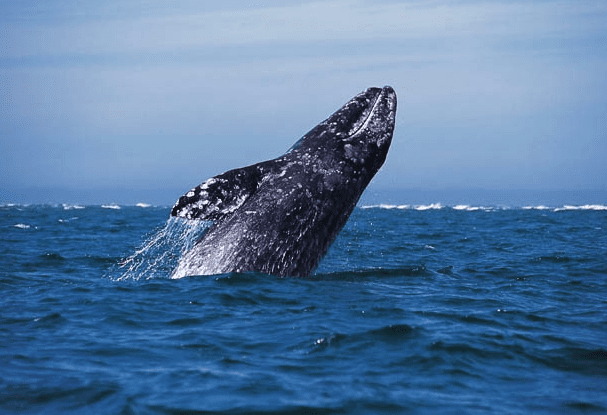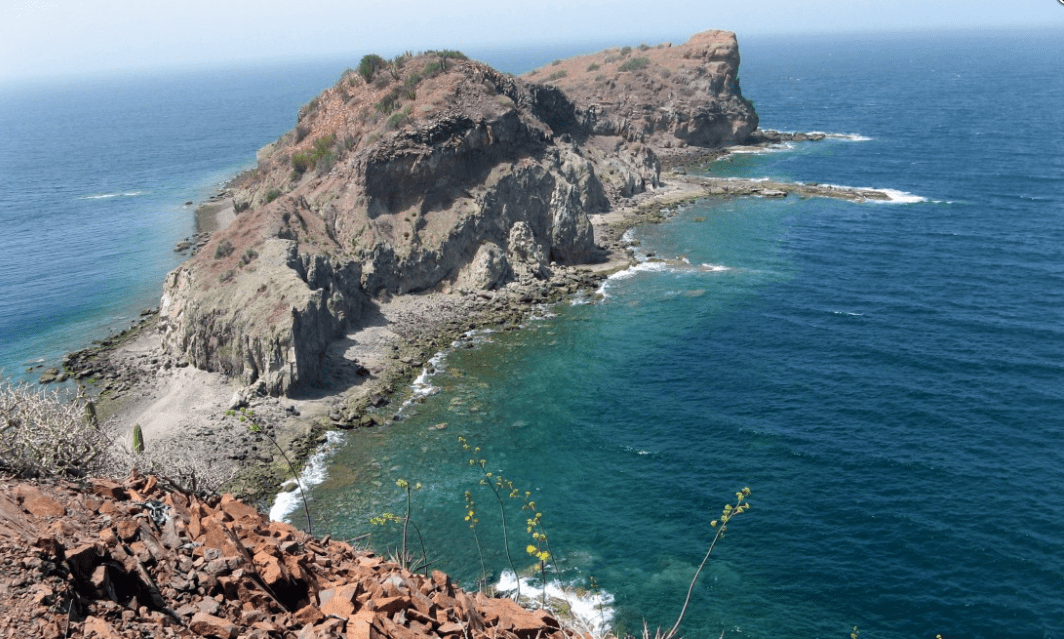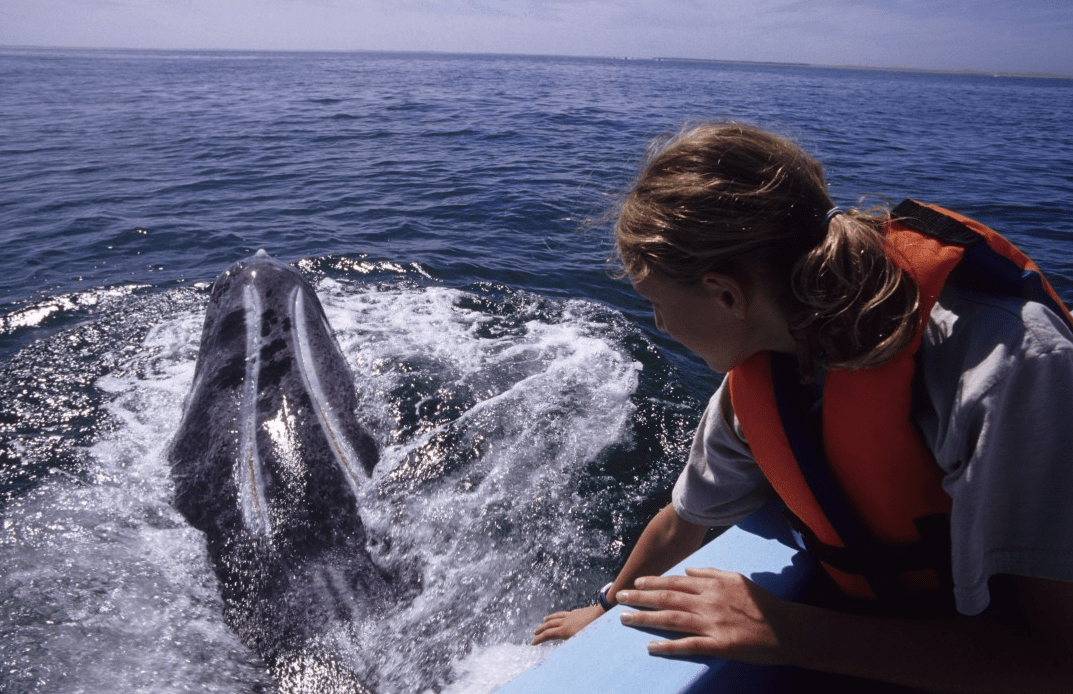By Margaret Backenheimer and J.D. Brown
When asked what single nature cruise is the most spectacular on Earth, we have a ready answer: a cruise of the Galapagos, located six hundred miles off the coast of Ecuador. But the Galapagos are far away, expensive to explore and congested with tour groups. Fortunately there's another choice that is nearer at hand, far less crowded and every bit as extraordinary: the "American Galapagos" located along western Mexico's Baja Peninsula. And while the Baja has no mammoth Galapagos turtles, it offers an even larger resident, the gray whales who winter here and who, when conditions are right, come right up to the boat and offer their enormous heads for a hands-on experience unlike any other.
Every year the magnificent gray whales migrate 5,000 miles south from Alaska along the Pacific coast to Baja's sheltered bays. Here they give birth, and it is also here that these leviathans, once hunted nearly to extinction by whalers, first began to frolic with local fishing boats in the 1970s, emerging for a reassuring pat on the head before returning north to Alaska. Today, Cruise West\'s small ships make sure that its passengers are there each winter to play among the calving whales, scouring the waters for close encounters of the largest kind. Mothers swim with their newborns, fattening them up and teaching them the skills they will need for the long migration north. For reasons that remain obscure, the whales also love to play hide-and-seek with the small fishing boats in Baja\'s Magdalena Bay, bobbing their heads out and bumping up against the hulls, nodding-indeed, almost smiling--when a passenger reaches out to caress their noggins. Our ship\'s tireless young cruise director, Meriwether Gill, could not guarantee every passenger a whale pat, but during our excursion in March just about everyone did just that, including, for the first time ever, Meriwether herself.
The gray whales did not take center stage until our second full day at sea, when our vessel was well north of its departure port, Cabo San Lucas, Baja\'s version of Cancun. The voyage began at twilight, brushing Cabo's El Arco, a stack of sea rocks and stone towers at Baja's southern cape. After cocktails and dinner, Meriwether and the ship\'s other expedition leaders laid out our six-day itinerary. The next day at sea was to set the tone, introducing us to the quietude and natural splendors of Baja, particularly the abundance of marine life shelved within the volcanic shores of the peninsula and the Mexican mainland. The Sea of Cortes was all but deserted, as blue-green as the Galapagos, the Caribbean or the Mediterranean, but nearly devoid of other cruise ships, freighters, or large port cities.
Our ship first anchored at Isla de Espiritu Santo, an islet acquired by the Mexican government from the Nature Conservancy in 2003. Its diverse ecosystem is intact, with its own endemic rabbits, squirrels, and cacti. A three-mile arc of sparkling sand known as Bonanza Beach made snorkeling and kayaking irresistible. We found deck chairs already pitched, beer and water in the cooler and kayaks lining the water's edge. The water was surprisingly nippy, around 70 degrees in winter, but Cruise West provided body suits and Meriwether and the other crew members on hand patiently taught the novices among us how to snorkel. The waters were transparent to the bottom, making snorkeling among the five hundred species of fish near the island well worth the plunge. The island\'s bay is a theater for diving brown pelicans, as well as magnificent frigate-birds, turkey vultures, Brandt\'s cormorants, and indigenous yellow-footed gulls. Below the surface the waters glowed with trumpetfish, urchins, sea stars, and balloonfish. Best of all, there was no one else on the whole island.
The hours drifted by and what became our evening routine recommenced at 5 p.m. back on board with a social hour in the lounge, a review of the day by the exploration leaders, dinner with its many choices of starters and entrees and a briefing on the next day\'s wonders. There is no casino, Las Vegas-style theater or swimming pool on this ship. The Sea of Cortes was to serve as our swimming pool, and its marine life as our entertainment.
To reach the sheltered bay where the gray whales calve, the ship docked inside the Sea of Cortes the next morning at Puerto Escondido, an abandoned tourism site that was once slated for development by the government. Chartered buses transported us over the Baja peninsula's Sierra de la Giganta range on a two-hour journey to the Pacific, affording us a view of this rugged landform, punctuated by tiny ranches, fields of cacti and nests of osprey pitched on special platforms atop the light poles. At Puerto Adolfo Lopez Mateos, a score of skiffs awaited us, oversized rowboats holding eight passengers and a guide, powered by outboard engines and steered by a local fisherman. For several hours we cruised the protected Bahia Magdalena lagoon in search of the gray whales, who reach 30 to 50 feet in length.
Once we spotted whales, our skiffs purred into position, and we waited in silence for them to resurface. Often it was a pair of leviathans, mother and newborn child, who came along side our open boats. When they were in the mood, the whales poked their heads out of the water and gently nudged the hull. Those visitors who dared made direct contact for a moment or two. Â During our two-hour run in the Bahia Magdalena, we were fortunate enough to find half a dozen mothers and babies that we could reach out and touch with our bare hands. Their heads were tough and rubbery, as Meriwether herself happily discovered.



The next day, our third full day at sea, was Captain's choice, which entailed a leisurely search among deserted islands in the Sea of Cortes for whales, seabirds and secluded beach spots where we indulged in more snorkeling, kayaking, beach-combing, and desert hiking. On our way to one small island beach, we were escorted by bottlenose dolphins; departing, we were shadowed by sperm whales, the species made famous by Moby Dick; and by sunset we were within sight of a pod of blue whales, the largest creature ever to inhabit the earth, measuring up to 100 feet in length and 150 tons in weight.
The following morning we paid a visit to Loreto, the first permanent Spanish settlement in the Baja (1697). Loreto was the "mother mission" for all of the Spanish colonial missions as far north as Sonoma in Northern California. Today it is a sleepy seaside village of 10,000, its waterfront bordered by a pretty promenade, its heart possessed by the old mission church. Inside we found a painting of the Virgin of Loreto brought ashore here by Padre Kino in 1607. We received a narrated tour of the church and the historical museum next door. Then we were free to discover Loreto for ourselves. In the afternoon the Loreto mission courtyard opened its gates for a private wine and cheese reception where local musicians serenaded us and Meriwether was surprised with a birthday cake.
Loreto is the quintessential Baja fishing village, home to several hundred expatriates from America and Europe unable to resist its laid-back charms, from the bars and ice cream parlors to the Internet cafes and craft shops. It was as difficult to depart Loreto as it was the lagoon of gray whales and the remote island beaches.
By the fifth full morning of cruising, we began to lose count of the days. We awakened at the islet of Los Islotes, one of the little seamounts that jut like castles of stone from the Sea of Cortes. This particular sea mirage has long been colonized by hundreds of California sea lions, and the crew shuttled us in closer for a chance to snorkel with playful juvenile and female sea lions. Our swim was limited to 30 minutes, but it was a magical half-hour snorkel. The sea lions circled, darted and tugged at us, eyeing us face-to-face, gnawing at our flippers, rubbing up against this human pod which had mysteriously been dropped into their midst. When they sped away from us, they carved designs through the deep like amphibious figure skaters.
A sixth day of sailing brought us into port again, this time at La Paz, near where the Spanish explorer Cortes founded a community in 1535 after his conquest of the Aztecs. La Paz has been the regional capital since 1829. In the 1950s it served as a deep-sea fishing hot spot for Hollywood celebrities. Now it is a shopping magnet for vacationing Mexicans and a handful of foreign travelers. In the afternoon Cruise West treated us to an all-out Mexican fiesta, complete with dancers and piñatas.
Dinner, dessert on the upper deck, an evening of stargazing and then, the next morning, our ship returned to the southernmost point in Baja California Sur, back to where we had set out a week earlier. The Arch was bathed by the sunrise, and our ship paused for picture-taking. We disembarked in Cabo San Lucas, shaking ourselves from a primordial dream in which we had touched whales and swum with sea lions, as if for a few days we had slipped back to the beginning of time and sailed the shores of an Eden.
J. D. Brown and Margaret Backenheimer are travel writers based in Oregon. Brown is the author of numerous guides to China for Frommer's and Berlitz. Backenheimer writes a weekly travel column for a major Midwest newspaper. Their articles and photos have appeared in hundreds of publications, including the New York Times, Islands, National Geographic Traveler, Hemispheres, the Denver Post, and the Los Angeles Times.